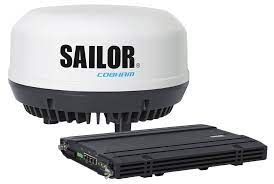Communication Options for Your Explorer Yacht
- Chris Leigh-Jones
- Dec 10, 2022
- 3 min read
Updated: Jan 20, 2023
When we take a small boat out into the expansive marshes of coastal South Carolina, help is simply a matter of calling on our ubiquitous smartphones. Woe betides the fool who thinks this strategy will work at sea. It's good for the first few miles and then - nothing. So what should we specify in this modern age of broadband connectivity and data streaming?
Photo - sunrise over the May River, Low Country of South Carolina, USA (where phones work!)
There is a pecking order to all this that we need to quantify. So let us remove the commerciality and assume connectivity can be rated as (****) and operating costs similarly ($$$$)
Mobile Phone - (*) ($)
Cell phones will work in the marina and inland waterways, but you will be alone in all other locations. For communication when sailing, it's pretty useless and borderline dangerous.
VHF - (**) ($)
The ever-present standby where a novice may think disaster awaits him in picking up the mike to answer, but we all quite quickly get familiar with the background chatter. VHF will provide for all your ship to shore or ship to ship communications plus the emergencies within range but nothing more demanding of bandwidth.
Reception depends on the height of your aerial and the distance to the recipient. So it's near the coast (< 20 miles) or another vessel. You can use this to transmit email and receive it similarly, but it is slow. Expect to be transported back to the age of the dial-up modem and leave Netflix alone.
Long Wave SSB (**) ($$)
Demanding hardcore sailors will be familiar with these systems and can receive over great distances with some practice. I'm not such a creature, so rather than repeat what I've read; we can stop at that point. Installation of the aerial takes some thought for the ground plane. We will fit an SSB but need to learn its uses better before blogging.
Geosynchronous Satellite Comms (***) ($$$$)
These are the Irridiums Certus and similar systems reliant on a small number of satellites in geosynchronous (fixed) orbit.
Data transmission rates and coverage is typically much more significant than previous, and they cover polar regions. Expect to be transported back to the 1990s as far as baud rates for data transmission. Costs can be eye-watering for anything other than voice or textual emails so no date streaming or Netflix.
Read also: An Instrument Mast for our Explorer Yacht
Low Earth Orbit Satellite Comms (****) ($$/$$$$)
These are the new boys on the block. The two familiar being Starlink and OneWeb. Both offer broadband connectivity similar too terrestial lines, but it comes with strings. Starlink initially locked its communications by location, but it now has a mobile version suitable for Recreational Vehicles traveling in-country. It has been implemented on yachts typically for coastal cruising but is only licensed to work is the USA at least when stationary and not underway (this may change). For example, a yacht plying the Amalfi Coast in Italy or PNW in USA/Canada and staying local.
Their international roaming service costs are out of our league (think superyachts). One Web has a different business model. Install costs are a good chunk, but run costs are reasonable, especially if you also intend to interact with your business while afloat. "Costs" split $$ to run and $$$$ to purchase. These systems will interface with a smartphone via the vessel WIFI, one instance we'd suggest a smartphone may be useful on a yacht.
We chose OneWeb or at least will fit it as soon as the new phases array aerials are available in early 2023. Starlink and OneWeb have coverage gaps that will reduce as additional satellite clusters are continually launched. Those gaps will be covered in the interim by our Iridium Sailor system. We purchased OneWeb through a distributor, OmniAccess, based in Majorca. They will also undertake the install so it looks like we will be stopping at Palma on our way out of the Mediterranean!
If you want your communications systems to behave at sea as they do in your home, these low orbit satellite systems are the way forward and will only improve with time. Broadband has finally made it to the seascape.
Chris Leigh-Jones
I remember the 1970's when a call home was once every two or three months. A few hours wait to be patched through by Portishead Radio only to often have no one answer. In these modern times, I wonder if such immediacy goes hand in hand with a false sense of security on the open ocean?
Useful links:
Ernesto Esposito
Sales Engineering Manager - OmniAccess
Fixed +34 971221979
Mobile +34 608716463

















Comments